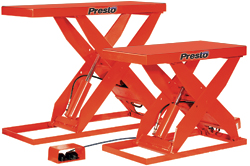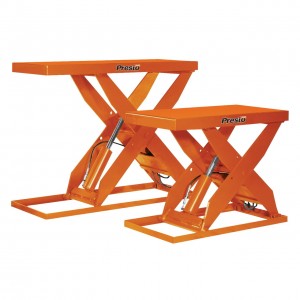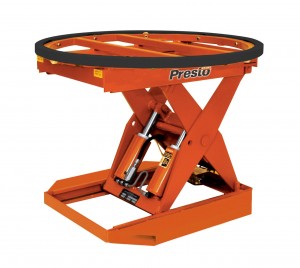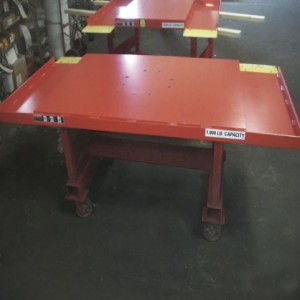 Once a hydraulic scissor lift is raised, it holds a vertical elevation by restricting the oil from passing back to the reservoir. Assuming there are not external leaks, whatever “seepage” of oil occurs by the cylinder seals, check valve or lowering valve will allow the lift to gradually drift down.
Once a hydraulic scissor lift is raised, it holds a vertical elevation by restricting the oil from passing back to the reservoir. Assuming there are not external leaks, whatever “seepage” of oil occurs by the cylinder seals, check valve or lowering valve will allow the lift to gradually drift down.
It takes sophisticated and very expensive valves to maintain near zero drift rates. Most industrial lifts don’t demand zero drift, a certain amount of drift down is considered acceptable, or normal.
The ANSI standard for scissor lifts and industrial tilters allows 3/4″ drift per hour on a 36″ travel unit. Presto Lifts has set a much higher standard of 3/16″ per hour drift on a 36″ travel unit.
Some other things to appreciate about drift down:
- 3/16″ is the maximum drift. Most standard lifts don’t exhibit noticeable drift down and are well within tolerance. But there is no guarantee.
- Holding maximum drift to 3/16″ can be as little as 1/2 a drop per minute on some lifts.
- The cylinder stroke is not linear to the lifts’ vertical travel. At the very bottom and very top of the travel, the cylinder stroke is minimal, a lift is more likely to have drift at these levels.
- Higher travel and larger capacity lifts are less sensitive to drift down. They require more displacement of oil to raise them and therefore are less sensitive to “drips per hour” to drift down. Unfortunately, the reverse is also true, the smallest, light duty lifts may be highly sensitive to drift down.
- As the oil warms and thins out, the viscosity lowers and the lift is more likely to drift down.
If an application requires a lift to hold an elevation, without drift, for an extended period of time, it must be addressed prior to the sale. There are several options that can minimize or stop drift altogether.
- Minimum Drift Valve: The down valve is a source of drift. Presto Lifts can add an additional valve at the pump to reduce seepage through the pump (and back to the reservoir).
- Mechanical Props: Support legs that fold down from the platform and assume the load from the hydraulics. These legs can be manual or powered.
 Here is a short but effective preventative maintenance schedule from Presto Lifts. Setting up a good maintenance program is the key to how well and how long your Presto Lift works for you. Regular maintenance helps prevent costly repairs and work slow down.
Here is a short but effective preventative maintenance schedule from Presto Lifts. Setting up a good maintenance program is the key to how well and how long your Presto Lift works for you. Regular maintenance helps prevent costly repairs and work slow down.







 Changing direction in a tight space is always a challenge. This automotive plant has a cart that needs to maneuver within a very tight work cell area several times a day. The solution needed to be floor level and rotate 360 degrees.
Changing direction in a tight space is always a challenge. This automotive plant has a cart that needs to maneuver within a very tight work cell area several times a day. The solution needed to be floor level and rotate 360 degrees. 